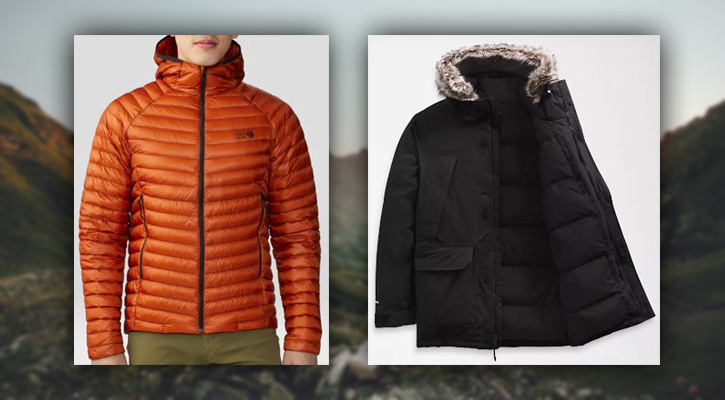
Mountain Hardwear is a better choice, in our opinion, if you need technical performance for challenging outdoor activities like climbing. The North Face is ideal if you want general outdoor gear and casual apparel with lots of style and design options.
But, why?
Read on to find out as we explore these brands’ history, main products, materials, and prices.
In the end, you’ll have a clearer idea of which one to choose for your next outdoor gear purchase.
Contents:
1. Mountain Hardwear Outdoor Gear
History of the Brand
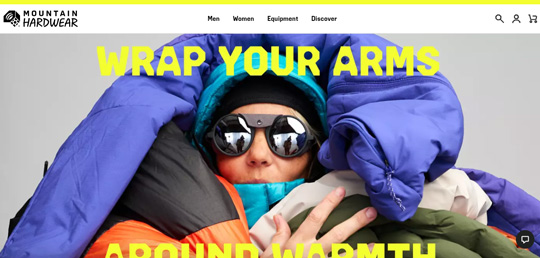
Mountain Hardwear’s official website
The Mountain Hardwear brand was born in California in 1993, founded by former employees of Sierra Designs. Ed Viesturs, the first American athlete to conquer fourteen 8,000-meter mountains, played a significant role in promoting the brand due to his remarkable achievements.
As a result, the company has maintained strong connections with Alpine athletes and their expeditions.
In 2003, Columbia Sportswear acquired the brand, marking a pivotal moment. A few years later, the first Mountain Hardwear retail store was established in Portland, Oregon in 2008, followed by another store in Seattle the same year, leading to the brand’s continued expansion.
Don’t miss: 8 Brands like Mountain Hardwear: Our Best Alternatives
Materials, Fabrics, and Production Process
Mountain Hardwear is renowned for its utilization of high-quality materials and innovative manufacturing methods, enabling its products to surpass expectations. Also, the apparel offers exceptional performance for outdoor enthusiasts and athletes.
The brand’s mountaineering equipment offers remarkable resistance and protection against low temperatures, boasting superb thermal insulation.
Mountain Hardwear consistently updates its production, innovating its designs to enhance athletes’ performance. The parkas, jackets, and other garments use natural down insulation, wool, and flannel fabrics, providing warmth even in the most frigid conditions.
Additionally, some of their jackets use fleece, a material similar to sheep’s wool that provides warmth while remaining soft on the skin. These materials provide durability, resilience, consistent body temperature maintenance, wind protection, and advanced technology.
Mountain Hardwear incorporates various fabric technologies such as Pertex Y Fuse, various performance levels of Gore-Tex, Dyneema Composite fabrics, and more.
Other notable warmth-providing materials in their products include PrimaLoft synthetic insulation and Polartec fleece. Also, the brand integrates RECCO® technology, an advanced rescue system, into some of its gear.
Sustainability is another element that is a key focus guiding the company’s production processes and business practices.
The video will be loaded from YouTube.com, a third party. If you play it, you accept their terms of service, and their use of cookies.
Read also: Mountain Hardwear vs Patagonia (Outdoor Gear Comparison)
Where is Mountain Hardwear outdoor gear made?
Mountain Hardwear’s items (together with other brands owned by Columbia) are primarily manufactured in Asia, including China, Bangladesh, India, and Vietnam. (source)
Recommended Products
Mountain Hardwear Men’s Ghost Whisperer/2 Hoody
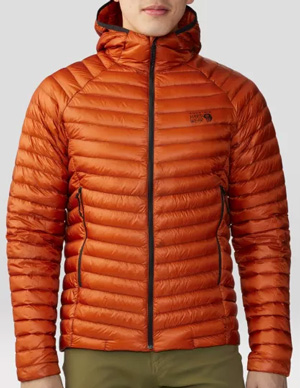
Image: mountainhardwear.com
Check it out at MountainHardwear.com
The Men’s Ghost Whisperer/2 Hoody offers an ultralight and packable design, making it suitable for various outdoor pursuits. Constructed from 100% recycled nylon and filled with 800-fill-power RDS-certified down, this jacket provides ethical warmth.
Tailored for a standard fit to allow freedom of movement, it incorporates practical features such as synthetic insulation at the cuffs, an adjustable hood, and zippered hand pockets. It can be conveniently compressed into its pocket for travel.
Weighing approximately 8.8 ounces (249 g) for a medium size, this hoody is both lightweight and warm, with a center-back length of 27.5 inches (69.9 cm). It represents a sustainable choice for environmentally-conscious adventurers looking for comfort during outdoor activities.
Mountain Hardwear Women’s JMT 25L Backpack
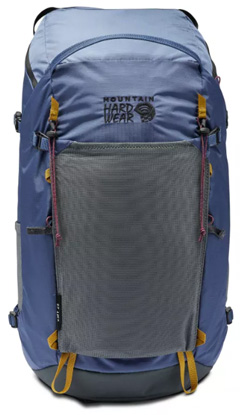
Image: mountainhardwear.com
Check it out at MountainHardwear.com
The Women’s JMT 25L Backpack is a sturdy and lightweight daypack crafted for outdoor pursuits like hiking and climbing. Constructed with a robust 500D CORDURA® base, it’s made for longevity.
This backpack is tailored for women, boasting a ventilated mesh back panel and fully cushioned shoulder straps to ensure comfortable transport. Its clamshell-style opening allows for effortless gear access, while the top zippered pocket facilitates organization.
Additionally, side compression straps aid in securing the load, and attachment loops are provided for trekking poles or an ice axe. With its simple design and essential features, the JMT 25L offers a pragmatic option for day hikers looking for a blend of performance and comfort.
Prices
Mountain Hardwear is typically considered a mid-to-high-priced brand, offering jackets ranging from $100 to $1,000 for specialized high-performance styles. As for backpacks, the designs of this brand are priced between $90 for daypacks and $450 for alpine packs.
Are Mountain Hardwear products worth the price?
According to online feedback, this company’s designs are well-regarded, with its products being described as durable, long-lasting, practical, and exceptionally comfortable. And we agree! Mountain Hardwear’s gear is definitely worth it!
Must read: 8 Best Sustainable Outdoor Clothing Brands: Our Top Picks
2. The North Face Outdoor Gear
History of the Brand
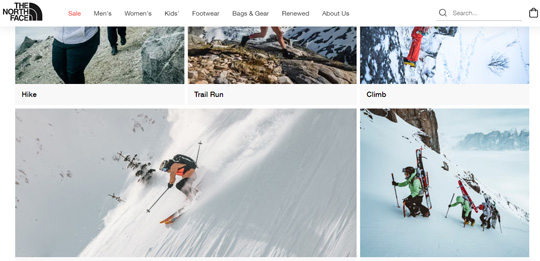
The North Face’s official website
The North Face is an American brand that is famous all over the world for its outdoor gear, boasting enduring popularity since its establishment in 1966. Initially recognized for its technical mountain clothing and equipment, the brand expanded its offerings to include hiking and casual packs, tents, sleeping bags, skiwear, and outerwear.
The widespread appeal of The North Face transcended the realm of technical wear in the 1990s, attracting a celebrity following. As an example, a rapper featured the Steep Tech jacket in a 1993 music video.
The brand’s name refers to the concept of “the north face” of a mountain in the northern hemisphere, which is known as the part of a mountain that is very cold and very difficult for ascents.
Don’t miss:
11 Brands like The North Face: Our Top Alternatives
12 Best American Jackets and Outdoor Clothing Brands
Materials, Fabrics, and Production Process
The North Face utilizes predominantly Nylon and Polyester, common materials among famous outdoor gear brands, and integrates multiple technologies into its products, including the FUTURELIGHT membrane. FUTURELIGHT uses a thin nanomembrane in jackets, letting air flow while at the same time repelling water.
Extensive testing has demonstrated its ability to withstand extreme outdoor conditions.
Next, The North Face utilizes goose down for thermal insulation, ensuring customers experience the necessary comfort and warmth during extended trips. This lightweight insulation also facilitates freedom of movement for challenging activities.
The brand’s products often incorporate Gore-Tex fabric technology, renowned for providing waterproofing, windproofing, and breathability. Gore-Tex effectively allows moisture to escape while preventing water penetration.
The North Face has also developed other technologies such as DryVent, WindWall, FlashDry, and the popular ThermoBall synthetic insulation.
The video will be loaded from YouTube.com, a third party. If you play it, you accept their terms of service, and their use of cookies.
Read also:
Eddie Bauer vs North Face (Side-by-Side Comparison)
The North Face vs Patagonia: Which is Better?
Where is The North Face outdoor gear made?
The majority of outdoor equipment by The North Face is manufactured in Asian countries like China, India, Bangladesh, and Vietnam, with some collections also being produced in the United States.
Recommended Products
The North Face Men’s McMurdo Parka
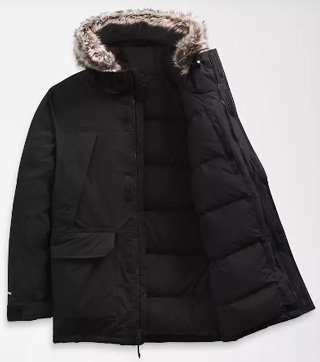
Image: thenorthface.com
Check it out at TheNorthFace.com
The Men’s McMurdo Parka offers exceptional warmth and protection from the elements. This long coat has a relaxed fit and is insulated with 600-fill-power recycled down, making it perfect for cold weather. It is windproof, waterproof, and breathable, featuring a seam-sealed DryVent™ 2L shell with a non-PFC DWR finish.
The parka includes practical features such as concealed, secure-zip chest pockets, two dual-entry front patch pockets, and a secure-zip internal chest pocket. It also comes with an attached, three-piece hood with an internal drawcord for adjustability and a removable faux-fur ruff, along with a storm flap covering the VISLON® front zip.
The parka has an embroidered logo on the left chest and back-right shoulder, adding style to its functionality. Adjustable hook-and-loop cuff tabs ensure a secure and comfortable fit, making the McMurdo a versatile and reliable choice for winter.
Read also: The North Face Diablo vs. Nuptse: Which Jacket is Better?
The North Face Borealis Backpack
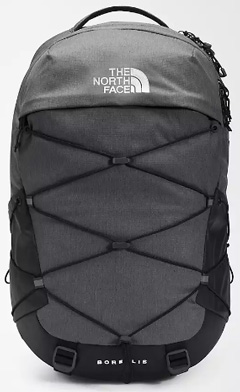
Image: thenorthface.com
Check it out at TheNorthFace.com
The Borealis stands out as a popular and adaptable pack crafted to deliver safety and utility for everyday requirements. Its distinctive bungee cord system and spacious interior compartment ensure secure storage.
The backpack’s upright structure, detachable waist belt, chest strap, and safeguarded laptop section make it suitable for diverse pursuits and settings. The FlexVent suspension system emphasizes comfort and stability, for a comfortable fit even during prolonged use.
For organization, the Borealis provides an external bungee-compression system, side bungee cords for compression, and bottom compression. It also features a protective dedicated laptop compartment, a sizable main compartment, and a front compartment with internal organization, secure-zip pockets, and a tablet sleeve.
Made of recycled nylon and polyester, it not only delivers practicality but also aligns with ethical principles. With its combination of functional attributes and design, the North Face Borealis Backpack is great for everyday use.
Read also: How To Wash a North Face Backpack: Step by Step
Prices
The products of The North Face are priced higher compared to numerous other outdoor gear brands. The brand falls within the mid-to-high price range. Their jackets cost between $70 and $800, while their backpacks range from $50 to around $300.
Are The North Face products worth the price?
If you are an avid mountain climber, skier, or explorer, The North Face gear justifies its cost in our opinion. Their equipment is crafted to deliver the comfort, utility, and effectiveness you need.
But, if you need everyday clothing, it depends on your preferences and budget. In general, you can find a couple of reasonably priced items from this brand.
Learn more: Why Is The North Face So Expensive and Popular? Are Its Jackets Worth It?
3. Which is Better? Mountain Hardwear or The North Face?
These are two popular brands when it comes to quality outdoor wear. To decide which is better for you, keep in mind these considerations:
- Reputation: Both are well-established and respected outdoor gear brands known for quality and performance. The North Face has more brand recognition among casual customers and those looking for fashionable designs.
- Specialization: Mountain Hardwear focuses more on technical climbing, mountaineering, and skiing gear. The North Face has a wider range including lifestyle and stylish apparel.
- Materials and Technology: Both use high-quality materials and fabrics like the standards Gore-Tex and PrimaLoft. Mountain Hardwear usually prioritizes lightweight and packable designs. The North Face offers a wider range of technical innovations and has also developed many technologies over the years including DryVent fabrics, Futurelight fabrics, Thermoball insulation, etc.
- Price: The North Face is generally less expensive, especially for basics like jackets and fleeces. Mountain Hardwear has premium prices for its technical gear.
- Weather protection: You can find excellent waterproof and breathable shells and insulated jackets from both brands. Mountain Hardwear has an edge for technical gear for extreme conditions like high-altitude mountaineering.
- Fit: Mountain Hardwear is designed for athletic body types and active movement. The North Face offers a more lifestyle-oriented fit.
In the end, Mountain Hardwear is a better choice, in our opinion, if you need technical performance for challenging outdoor activities like climbing. The North Face is ideal if you want general outdoor gear and everyday apparel with lots of style options.
Read next: The North Face vs Arc’teryx: Which Brand is Better?
